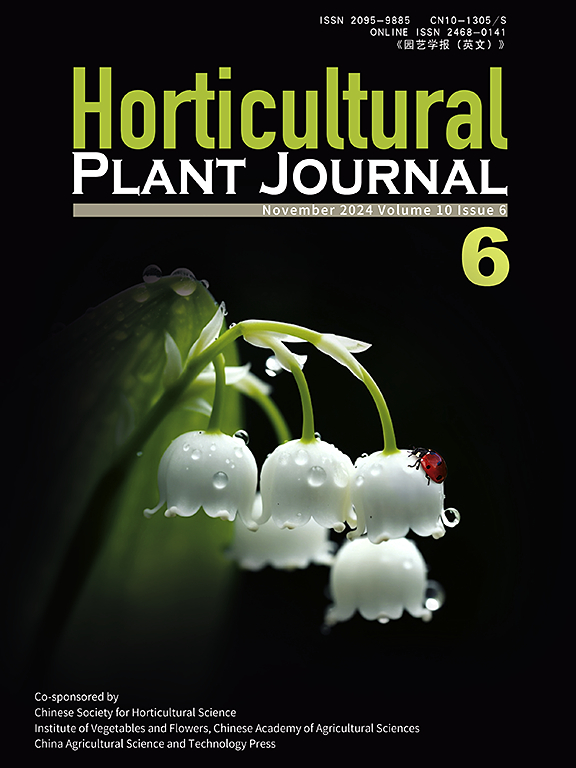PomiR164靶向PoLBD25促进牡丹早花
IF 6.2
1区 农林科学
Q1 HORTICULTURE
引用次数: 0
摘要
牡丹(Paeonia Section Moutan DC.)是一种珍贵的观赏植物,其花期短且集中,限制了其经济和美学价值。microrna在牡丹花期调控中起着至关重要的作用。在这项研究中,我们分析了牡丹(Paeonia suffruticosa)连续花期的小rna,并确定miR164是一个假定的花期调节因子。双荧光素酶报告基因结合在本烟中共表达的实验表明,miR164直接识别并促进PoLBD25转录本的降解。在牡丹基因组的挖掘中,发现了25个LBD同源物(PoLBD1-25),这些同源物非随机分布在5条染色体上,并根据它们的理化性质进行了系统的命名。qRT-PCR结果显示,polbd在花期均有表达,其中色暴露期表达量最高。通过同源瞬时转化和异源稳定转化,获得了PomiR164和PoLBD25基因表达改变的转基因牡丹和过表达这些基因的转基因烟草。PomiR164a过表达促进提前开花,沉默导致延迟开花。相比之下,PoLBD25过表达延迟开花,其沉默导致提早开花。综上所述,我们的研究阐明了PomiR164-PoLBD25模块在牡丹花期调控中的关键作用,为牡丹的花期调控和遗传育种提供了理论依据。本文章由计算机程序翻译,如有差异,请以英文原文为准。
PomiR164 targets PoLBD25 to promote early flowering in tree peony
Tree peony (Paeonia Section Moutan DC.), a highly valued ornamental plant, has a short and concentrated blooming period, which limits its economic and aesthetic value. MicroRNAs play a crucial role in regulating the flowering time in peony. In this study, we profiled small RNAs across sequential floral stages of tree peony (Paeonia suffruticosa ) and identified miR164 as a putative flowering-time regulator. Dual-luciferase reporter assays coupled with co-expression in Nicotiana benthamiana demonstrated that miR164 directly recognizes and promotes the degradation of PoLBD25 transcripts. Mining of the peony genome recovered 25 LBD homologues (PoLBD1–25) that are non-randomly distributed on five chromosomes and were systematically designated according to their physicochemical properties. qRT-PCR revealed that PoLBDs were expressed throughout the flowering stages, with the highest expression during the color-exposure stage. Using homologous transient transformation and heterologous stable transformation, we obtained transgenic peony with altered expression of PomiR164 and PoLBD25 genes and transgenic tobacco overexpressing these genes. PomiR164a overexpression promoted early flowering, and silencing caused delayed flowering. In contrast, PoLBD25 overexpression delayed flowering, and its silencing resulted in early flowering. Taken together, our study elucidates the critical role of the PomiR164–PoLBD25 module in regulating the flowering time in peony, providing a theoretical basis for flowering control and genetic breeding in peony.
求助全文
通过发布文献求助,成功后即可免费获取论文全文。
去求助
来源期刊

Horticultural Plant Journal
Environmental Science-Ecology
CiteScore
9.60
自引率
14.00%
发文量
293
审稿时长
33 weeks
期刊介绍:
Horticultural Plant Journal (HPJ) is an OPEN ACCESS international journal. HPJ publishes research related to all horticultural plants, including fruits, vegetables, ornamental plants, tea plants, and medicinal plants, etc. The journal covers all aspects of horticultural crop sciences, including germplasm resources, genetics and breeding, tillage and cultivation, physiology and biochemistry, ecology, genomics, biotechnology, plant protection, postharvest processing, etc. Article types include Original research papers, Reviews, and Short communications.
 求助内容:
求助内容: 应助结果提醒方式:
应助结果提醒方式:


